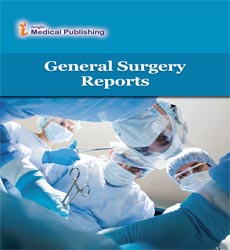Advancements in Robotic Colorectal Surgery: Precision, Minimally Invasive Techniques and Enhanced Patient Outcome
James Clune*
Department of Surgery, University of Wenzhou Medical, New Haven, USA
- *Corresponding Author:
- James Clune
Department of Surgery, University of Wenzhou Medical, New Haven,
USA,
E-mail: clune@gmail.com
Received date: May 15, 2024, Manuscript No. IPGSR-24-19068; Editor assigned date: May 17, 2024, PreQC No. IPGSR-24-19068 (PQ); Reviewed date: May 30, 2024, QC No. IPGSR-24-19068; Revised date: June 06, 2024, Manuscript No. IPGSR-24-19068 (R); Published date: June 13, 2024, DOI: 10.36648/2393-8854.11.2.163
Citation: Clune J (2024) Advancements in Robotic Colorectal Surgery: Precision, Minimally Invasive Techniques and Enhanced Patient Outcome. Gen Surg Rep 11.2:163.
Description
Robotic colorectal surgery represents a significant advancement in surgical techniques for treating various colorectal conditions, including colorectal cancer, inflammatory bowel disease, diverticulitis and benign colorectal tumors. This innovative approach combines the precision of robotic technology with the expertise of skilled surgeons to perform minimally invasive procedures with enhanced dexterity and visualization. As a result, patients may experience faster recovery times, reduced pain, and improved outcomes compared to traditional open surgery or laparoscopic techniques. At the core of robotic colorectal surgery is the da Vinci Surgical System, a sophisticated robotic platform that enables surgeons to perform complex procedures with greater precision and control. The system consists of several components, including a console where the surgeon sits, immersive 3D visualization, robotic arms equipped with surgical instruments and a high-definition camera. These components work together seamlessly, allowing the surgeon to manipulate the instruments with precise movements while viewing a magnified, high-definition image of the surgical site.
Robotic surgery
One of the key advantages of robotic surgery is its enhanced dexterity, which surpasses the capabilities of the human hand. The robotic arms can rotate 360 degrees and mimic the natural movements of the surgeon's hands with greater lexibility and range of motion. This precision is particularly beneficial in delicate procedures involving intricate anatomical structures in the pelvis and abdomen, such as rectal resections or sphincterpreserving surgeries. Moreover, the immersive 3D visualization provided by the da Vinci system offers unparalleled clarity and depth perception, allowing surgeons to navigate complex anatomical structures with confidence and accuracy. This enhanced visualization is especially important in colorectal surgery, where precise dissection and preservation of surrounding tissues are essential for optimal outcomes. Another significant advantage of robotic colorectal surgery is its minimally invasive nature. Unlike traditional open surgery, which requires large incisions and extensive tissue dissection, robotic surgery involves small keyhole incisions through which the robotic arms and camera are inserted. These smaller incisions result in less trauma to the surrounding tissues, reduced blood loss and faster recovery times for patients. Additionally, the magnified, high-definition view provided by the robotic camera allows surgeons to perform precise maneuvers in tight spaces, minimizing the risk of damage to adjacent structures.
Surgery experience
Robotic colorectal surgery offers several other potential benefits for patients, including reduced postoperative pain, shorter hospital stays, and quicker return to normal activities. Studies have shown that patients undergoing robotic colorectal surgery experience less postoperative pain and require fewer pain medications compared to those undergoing traditional open surgery. Additionally, the smaller incisions and reduced tissue trauma associated with robotic surgery contribute to shorter hospital stays and faster recovery times, allowing patients to resume their normal activities sooner. Despite these advantages, robotic colorectal surgery may not be suitable for all patients or all types of colorectal conditions. Factors such as the patient's overall health, the extent and location of the disease, and the surgeon's expertise should be taken into consideration when determining the most appropriate surgical approach. In some cases, traditional open surgery or laparoscopic techniques may be more appropriate depending on the individual patient's needs and circumstances. In conclusion, robotic colorectal surgery represents a groundbreaking approach to treating colorectal conditions with precision, efficiency, and improved patient outcomes. By harnessing the power of robotic technology, surgeons can perform complex procedures with enhanced dexterity, visualization, and minimally invasive techniques. While robotic surgery may not be suitable for every patient or every situation, it offers significant advantages for many individuals undergoing colorectal surgery, paving the way for a new era of surgical excellence and patient care.
Open Access Journals
- Aquaculture & Veterinary Science
- Chemistry & Chemical Sciences
- Clinical Sciences
- Engineering
- General Science
- Genetics & Molecular Biology
- Health Care & Nursing
- Immunology & Microbiology
- Materials Science
- Mathematics & Physics
- Medical Sciences
- Neurology & Psychiatry
- Oncology & Cancer Science
- Pharmaceutical Sciences
